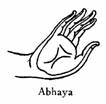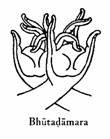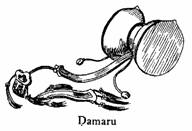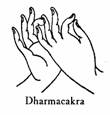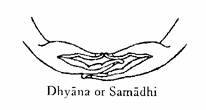|
Abhaya (Sk) |
Gesture of protection |
|
|
|
|
|
|
|
Actions
|
The process in which good action produces
happiness and vice versa. |
|
|
|
|
Acala
(Sk)
|
Acala-Vajrapani
, is a member of the dharmapala.
(See Photos 45, 46.) |
|
|
|
|
Adi-Buddha (Sk) |
"The Primordial Buddha" The
unsubstantiated source of the cosmic mind. |
|
|
|
|
Ahimsa (Sk)
|
Compassion for all life forms. |
|
|
|
|
|
Rock
caves in the |
|
|
|
|
Akshobya
(Sk)
|
One
of the Dhyani Buddhas. |
|
|
|
|
Amitayus (Sk) |
"Buddha
of Infinite Life". One of the five
Dhyani Buddhas; in fact, another form of Amitabha. Seated in
Dhyanasana
or standing. Holds a kalasa in
Dhyani-mudra. Never with Sakti
. |
|
|
|
|
Amoghapasa
(Sk) |
A
tantric
form of Avalokitesvara
. (See Photos 32, 33.) |
|
|
|
|
Amoghasiddhi (Sk) |
"Unfailing Power". One of the Dhyani Buddhas. (See Photo 26.) |
|
|
|
|
Amulets (Sk)
|
Gahu
. Amulet boxes are usually made of
bronze
or copper
and are inscribed with religious
diagrams. The boxes can contain seeds, bits of cloth, votive clay
plaques, images of the deity who
the owner believes protect them and folded prayers and sometimes even a
tatty photograph of the present Dalai Lama
. Amulet boxes are worn about the
neck, waist or hang from the saddle of a horse or yak. (See Photo 9.) |
|
|
|
|
Ananda
(Sk) |
Main
disciple of Buddha
. The word loosely translates also
into the phrase "spiritual ecstasy". |
|
|
|
|
Anjali-mudra
(Sk) |
A
greeting posture. Both arms are stretched upwards and both palms are also
turned upwards with all fingers extended. |
|
|
|
|
|
|
|
Ankusa
(Sk) |
Elephant goad
. Tantric symbol. |
|
|
|
|
|
|
|
Apron |
Sanmudras
. Human bone
apron. (See Photo 11.) |
|
|
|
|
Apsara
(Sk) |
A
female nature spirit or fairy. |
|
|
|
|
Ardhaparyankasana (Sk) |
Dancing posture. Standing on one foot. |
|
|
|
|
Arhat
(Sk) |
A
Bodhissatva
. |
|
|
|
|
Arrow |
See
Sara |
|
|
|
|
Arya
(Sk) |
A
superior being. |
|
|
|
|
Aryan
(Sk) |
Noble, as in worthy. |
|
|
|
|
Asana
(Sk) |
Position of lower limbs. |
|
|
|
|
Asceticism |
A
self mortification and renunciation of all worldly pleasure for the
ultimate reward of total pleasure and release from
suffering
. The Buddha
rejected asceticism as useless and
selfish. |
|
|
|
|
Great Buddhist emperor of | |
|
|
|
|
A
red flower with small jagged leaves. | |
|
|
|
|
|
|
|
Asvaghosa
(Sk) |
The 5th century AD scholar and teacher,
revered by many as the true founder of Mahayanist Buddhism. |
|
|
|
|
Atapatra
(Sk) |
Parasol. A symbol. |
|
|
|
|
|
|
|
Atisa
(Sk) |
A
deified Hindu
priest, AD 982-1054, who became a
Buddhist and founded the Kadam-pa sect
. |
|
|
|
|
Atman
(Sk) |
The
soul. |
|
|
|
|
"Hail to the Jewel in the Lotus
." A most holy invocation repeated
to prevent rebirth
. | |
|
|
|
|
Avalokitesvara
(Sk) |
See
also Chenresi
. Also called Padmapani
. A Bodhissatva
who cares for the people
on earth. He has 108 forms! |
|
|
|
|
Avatar
(Sk) |
An
incarnation. |
|
|
|
|
A
tantric
work describing the process of how
a dying person passes through the realms of death
and rebirth
. See section on wheel of life. | |
|
|
|
|
Beg-tse
(T) |
Brother-sister. One of the Dharmapala
. |
|
|
|
|
|
See
Ghanta
. |
|
|
|
|
Bhadrasana
(Sk) |
A
both legs pendant posture. |
|
|
|
|
Bhairava
(Sk) |
Also
known as Yamantaka
one of the Dharmapala
(See Photos 55, 56.) |
|
|
|
|
Bhaisajyaguru
(Sk) |
Manla
(T) "Supreme Doctor". See Medicine
Buddhas
. |
|
|
|
|
Bhikshu
(Sk) |
Monk
who has dedicated himself to the path of rigid observance of the Buddhist
religion
. |
|
|
|
|
Bhumisparsa-mudra
(Sk) |
The
earth-touching position in which the Buddha
calls the earth to witness his
sacrifices to achieve Nirvana
. |
|
|
|
|
|
|
|
Bhutadamara
(Sk) |
Gesture of awe. Inspiring. |
|
|
|
|
|
|
|
Bodhi
(Sk) |
Enlightenment. |
|
|
|
|
Bodhissatva
(Sk) |
Buddha
of the future. Those who work for
the good of mankind, refusing voluntarily to enter Nirvana
. |
|
|
|
|
Bon
(T) |
The
pre-Buddhist religion
of
|
|
|
|
|
Book
cover |
Carved in wood
, highly decorative. Used to contain
sacred texts. (See Photo 14.) |
|
|
|
|
Bow |
See
Capa. |
|
|
|
|
"The
Enlightened One" Siddharta
Gotauma
. The seventh century BC prince who
renounced his position to become an ascetic and a teacher, founding the
Buddhist philosophy
. (See Photo 24.) | |
|
|
|
|
The
place where Buddha attained Nirvana
. The actual spot is marked by a
Bo-tree, still there, but protected from the devoted.
| |
|
|
|
|
Buddhasramana
(Sk) |
Gesture of salutation. |
|
|
|
|
|
|
|
One
who accepts the teachings of Buddha
as his religion
. | |
|
|
|
|
Caitya
(Sk)
|
Stupa
(Sk) Chorten
(T) A shrine reliquary. The most
venerated Buddhist artifact. Reputed to contain the mortal remains of the
Buddha
. Most often contains the ashes of a
great Lama
or Abbot. The shape of a stupa is
often described philosophically as representing from bottom to top (A) the
earth, (B) steps of attainment, (C) water, for transformation, (D) fire,
of endeavour, (E) breath
, (F) moon, for spirit and light.
The practice of anthill worship in Indian prehistoric times has been
suggested as a possible beginning to the history of the stupa and its
worship. |
|
|
|
|
|
|
|
Caste |
Class distinctions of Aryan
and non Aryan existed during
Buddhas life. No class distinctions occur in the monastery
. |
|
|
|
|
Cakra
(Sk) |
Buddhist wheel. Perfection and completeness. Eight
spokes. |
|
|
|
|
|
|
|
Camara
(Sk) |
The
tail of a horse or yak used as a fly whisk. A tantric
symbol. |
|
|
|
|
|
|
|
Campa
(Sk) |
A
white flower. |
|
|
|
|
|
|
|
Candra (Sk) |
Moon. |
|
|
|
|
|
|
|
Capa
(Sk) |
Bow
(as in arrow). |
|
|
|
|
|
|
|
Charms |
Mostly paper
, either to be eaten as a cure
against disease, or worn as a protection against evil spirits or forces.
See Amulet, Gahu
. |
|
|
|
|
Chenresi
(T) |
See
Avalokitesvara
. |
|
|
|
|
Chien
Lung
(1736-1796) |
Chinese
Buddhist emperor. A great patron of
the arts. He gifted his mother the empress a huge collection of
bronze
images, constituting a Lamaist
pantheon. |
|
|
|
|
Child
Buddha |
Siddharta
Gotauma
as a baby. Sometimes depicted in
Chinese
sculpture, but rarely in
Tibetan
art. |
|
|
|
|
Chopen
(T) |
A
five pointed crown worn in ceremonies. |
|
|
|
|
(T)
See Caitya
. | |
|
|
|
|
Churi
(Sk) |
A
curved dagger. A tantric
symbol. |
|
|
|
|
|
|
|
Cintamani
(Sk) |
Sacred jewel. |
|
|
|
|
|
|
|
Colours |
Colours, like symbols, tend to identify the family group to which
the particular item belongs. The problems of regional differences in
|
|
|
|
|
Conch |
A
sacred seashell used as a trumpet. See Sankha
. |
|
|
|
|
Cymbals |
Ritual items of brass or bell-metal used in the music of ritual.
See Dingsha
. |
|
|
|
|
Dakini
(Sk) |
Lower ranking goddesses
who assist in Tantric rites, often
seen dancing and holding sacred symbol. There are many dakinis, but the
'Group of Five' which correspond to the 'Five Buddhas of Space', East,
West, North, South and the historical Buddha
as the Zenith, are the most well
known. (See Photo 58.) |
|
|
|
|
Dalai-Lama
(T) |
Precious Protector. Spiritual and temporal monarch of
|
|
|
|
|
Damaru
(Sk) |
A
drum made of two skulls, one male and one female, fitted, sometimes with
human-skin. A tantric
symbol. (See Photo 10.) |
|
|
|
|
|
|
|
Danda
(Sk) |
A
staff with a vajra or skeleton top. A tantric
symbol. |
|
|
|
|
|
|
|
Deva
(Sk) |
An
angel, both good and bad. |
|
|
|
|
Dharma
(Sk) |
Buddhist law. Although the Buddha
left no written record of his
teachings - his disciples are believed to have committed them to memory
and transmitted them orally from generation to generation. |
|
|
|
|
Dharma -cakra-mudra (Sk) |
"Spinning the Wheel of the Law." A teaching posture in which the
right hand is held at the breast, with the united tips of the index finger
and thumb touching one of the fingers on the left hand. |
|
|
|
|
|
|
|
Dharmapala
(Sk) |
"Defenders of the Buddhist Law." Also known as the 'Eight Terrible
Ones', they are often shown in ferocious aspect. They are
Beg-tse
, Hayagriva
, Kubera
, Mahakala
, Sitabramha
, Sridevi
, Yama
and Yamantaka
. |
|
|
|
|
Dhyanasana
(Sk) |
A
posture of meditation
. The legs are locked in full-lotus
position, with the soles of the feet upwards and visible.
|
|
|
|
|
Dhyanibodhissatvas
(Sk) |
Meditative future Buddhas. These are the five creators of the
universe. Avalokitesvara
, Samantabhadra, Vajrapani
, Ratnapani
and Visvapani
. There is a further group of eight
more. |
|
|
|
|
Dhyanibuddhas
(Sk) |
Meditative Buddhas. These are the five spiritual sons of the
'Primordial Buddha
.' They are: Vairocana
, Aksobhya, Ratnasambhava
, Amitabha and Amoghasiddhi
. |
|
|
|
|
Dhvaja
(Sk) |
Victory banner. |
|
|
|
|
|
|
|
Dhyani-mudra
(Sk) |
A
posture of meditation
. The hand lie in the lap, right
over left with fingers extended and palms upwards. Also called
Samadhi
(Sk). |
|
|
|
|
|
|
|
Dingsha
(T) |
Small cymbals on a chain used in exorcism ritual. |
|
|
|
|
Dipankara
(Sk) |
'Enlightened One'. In an earlier word cycle he was the historical
Buddha
's teacher. |
|
|
|
|
Disciples |
The
two most popular disciples of Buddha
depicted in paintings
and accompanying sculptures
are: Maudgalyayana
and Sariputra. They are usually
shown on each side of Buddha and wear the robes of a monk. |
|
|
|
|
Dorje
(T) |
See
Vajra
. (See Photo 7.) |
|
|
|
|
Drilbu
(T) |
Ghanta
. A bell of bronze
with a vajra handle used in most
rituals
. See Ghanta. |
|
|
|
|
Dzogchen
(T) |
'The
Great Perfection' A Nyingma-pa
tradition in which the
stabilisation of awareness is taught via the tantric
practice in which the generation
and completion stages are effortlessly present. |
|
|
|
|
Eight Precious
Emblems |
Found engraved, written or cast on many ritual items, they are: the
endless knot, wheel of life, lotus, standard, vase, two fish (tail to
tail) and (mouth to mouth), white parasol and conch shell. |
|
|
|
|
Elephant
goad |
See
Ankusa
. |
|
|
|
|
Elephants |
Usually supports or mounts for deities
. |
|
|
|
|
Endless
Knot |
Ancient Chinese
symbol of longevity. |
|
|
|
